4[1]_Ancient_Chinese_Education中国传统文化
- 格式:ppt
- 大小:5.89 MB
- 文档页数:35
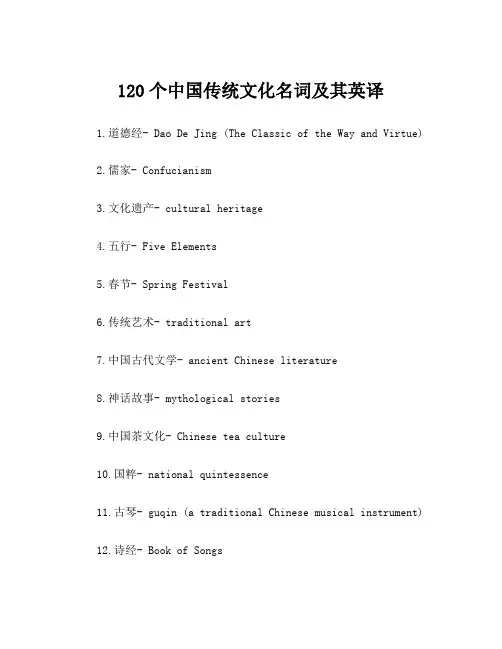
120个中国传统文化名词及其英译1.道德经- Dao De Jing (The Classic of the Way and Virtue)2.儒家- Confucianism3.文化遗产- cultural heritage4.五行- Five Elements5.春节- Spring Festival6.传统艺术- traditional art7.中国古代文学- ancient Chinese literature8.神话故事- mythological stories9.中国茶文化- Chinese tea culture10.国粹- national quintessence11.古琴- guqin (a traditional Chinese musical instrument)12.诗经- Book of Songs13.行书- running script (a style of Chinese calligraphy)14.红楼梦- Dream of the Red Chamber15.京剧- Beijing Opera16.四书五经- Four Books and Five Classics (Confucian classical texts)17.中医- Traditional Chinese Medicine (TCM)18.书法- calligraphy19.文房四宝- Four Treasures of the Study (brush, ink stick, inkstone, and paper)20.传统节日- traditional festivals21.工艺品- handicrafts22.长城- Great Wall23.农历- lunar calendar24.中国画- Chinese painting25.合作共赢- win-win cooperation26.四合院- quadrangle courtyard27.曲艺- Chinese folk art28.灯笼- lantern29.传统婚礼- traditional wedding ceremony30.拜年- pay a New Year visitAdditional Extension:31.古人- ancient people32.传统建筑- traditional architecture33.传统音乐- traditional music34.陶瓷艺术- ceramic art35.传统戏剧- traditional drama36.中国历史- Chinese history37.长街短巷- long streets and alleys38.风水- Feng Shui39.传统服饰- traditional costumes40.中国象棋- Chinese chess41.中国民歌- Chinese folk songs42.传统美食- traditional cuisine43.传统医学- traditional medicine44.传统童谣- traditional nursery rhymes45.传统工艺- traditional craftsmanship46.传统家具- traditional furniture47.传统舞蹈- traditional dance48.传统庙宇- traditional temples49.传统阳历- traditional solar calendar50.中国春联- Chinese New Year couplets。
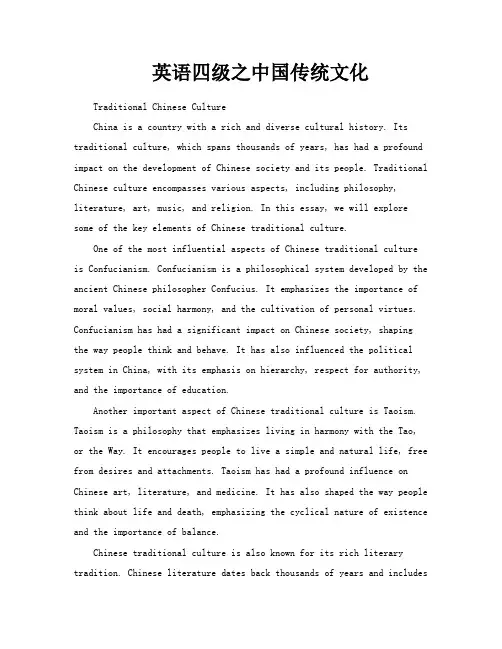
英语四级之中国传统文化Traditional Chinese CultureChina is a country with a rich and diverse cultural history. Its traditional culture, which spans thousands of years, has had a profound impact on the development of Chinese society and its people. Traditional Chinese culture encompasses various aspects, including philosophy, literature, art, music, and religion. In this essay, we will explore some of the key elements of Chinese traditional culture.One of the most influential aspects of Chinese traditional culture is Confucianism. Confucianism is a philosophical system developed by the ancient Chinese philosopher Confucius. It emphasizes the importance of moral values, social harmony, and the cultivation of personal virtues. Confucianism has had a significant impact on Chinese society, shaping the way people think and behave. It has also influenced the political system in China, with its emphasis on hierarchy, respect for authority, and the importance of education.Another important aspect of Chinese traditional culture is Taoism. Taoism is a philosophy that emphasizes living in harmony with the Tao, or the Way. It encourages people to live a simple and natural life, free from desires and attachments. Taoism has had a profound influence on Chinese art, literature, and medicine. It has also shaped the way people think about life and death, emphasizing the cyclical nature of existence and the importance of balance.Chinese traditional culture is also known for its rich literary tradition. Chinese literature dates back thousands of years and includesvarious genres, such as poetry, prose, and drama. One of the most famous works of Chinese literature is "Dream of the Red Chamber," a novel written in the 18th century by Cao Xueqin. It is considered a masterpiece of Chinese literature and explores themes of love, family, and the rise and fall of dynasties.In addition to literature, Chinese traditional culture is also known for its beautiful art and music. Chinese painting, for example, is characterized by its emphasis on brushwork and the use of ink and watercolors. Chinese calligraphy is another important art form, with its intricate strokes and elegant characters. Traditional Chinese music, on the other hand, is known for its melodic and soothing tones. Instruments such as the guqin, pipa, and erhu are commonly used in traditional Chinese music.Religion is another important aspect of Chinese traditional culture. Buddhism, which originated in India, was introduced to China more than two thousand years ago and has since become one of the major religions in the country. Buddhism emphasizes the practice of meditation and the pursuit of enlightenment. It has had a profound influence on Chinese culture, shaping the way people think about life, death, and the afterlife.In conclusion, Chinese traditional culture is a rich and diverse heritage that has shaped the development of Chinese society and its people. From Confucianism to Taoism, from literature to art and music, and from Buddhism to calligraphy, Chinese traditional culture encompasses a wide range of elements that have had a profound impact on Chinese society. It is a culture that values moral values, socialharmony, and the cultivation of personal virtues. It is a culture that celebrates beauty and seeks balance in all aspects of life.。

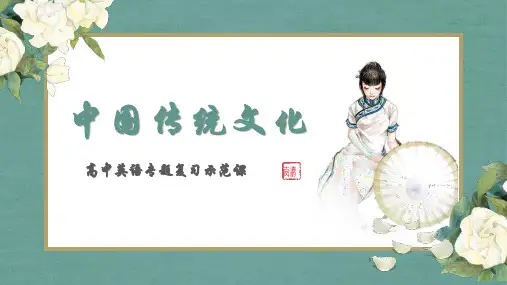
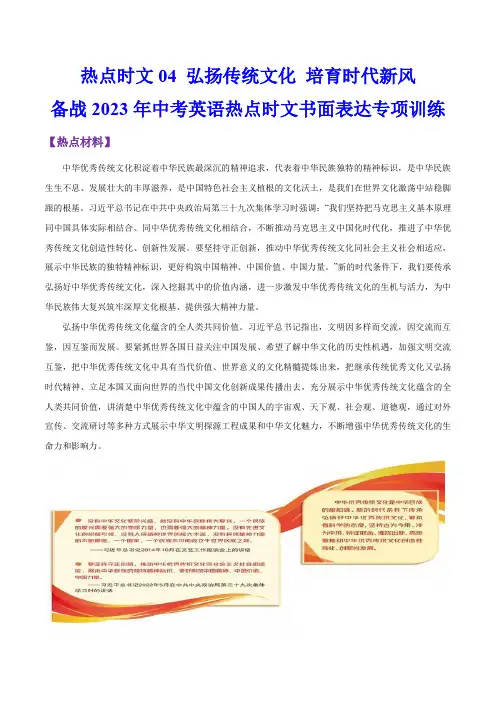
热点时文04 弘扬传统文化培育时代新风备战2023年中考英语热点时文书面表达专项训练【热点材料】中华优秀传统文化积淀着中华民族最深沉的精神追求,代表着中华民族独特的精神标识,是中华民族生生不息、发展壮大的丰厚滋养,是中国特色社会主义植根的文化沃土,是我们在世界文化激荡中站稳脚跟的根基。
习近平总书记在中共中央政治局第三十九次集体学习时强调:“我们坚持把马克思主义基本原理同中国具体实际相结合、同中华优秀传统文化相结合,不断推动马克思主义中国化时代化,推进了中华优秀传统文化创造性转化、创新性发展。
要坚持守正创新,推动中华优秀传统文化同社会主义社会相适应,展示中华民族的独特精神标识,更好构筑中国精神、中国价值、中国力量。
”新的时代条件下,我们要传承弘扬好中华优秀传统文化,深入挖掘其中的价值内涵,进一步激发中华优秀传统文化的生机与活力,为中华民族伟大复兴筑牢深厚文化根基、提供强大精神力量。
弘扬中华优秀传统文化蕴含的全人类共同价值。
习近平总书记指出,文明因多样而交流,因交流而互鉴,因互鉴而发展。
要紧抓世界各国日益关注中国发展、希望了解中华文化的历史性机遇,加强文明交流互鉴,把中华优秀传统文化中具有当代价值、世界意义的文化精髓提炼出来,把继承传统优秀文化又弘扬时代精神、立足本国又面向世界的当代中国文化创新成果传播出去,充分展示中华优秀传统文化蕴含的全人类共同价值,讲清楚中华优秀传统文化中蕴含的中国人的宇宙观、天下观、社会观、道德观,通过对外宣传、交流研讨等多种方式展示中华文明探源工程成果和中华文化魅力,不断增强中华优秀传统文化的生命力和影响力。
【典型范文】中国传统文化中蕴含着丰富的智慧与处世理念。
古语有云:“单丝不成线,独木不成林。
”请你结合下图,以“Working with others”为主题,联系身边事例,写一篇英语短文。
提示:1) Describe the picture.2) Share one of your past experiences.3) Tell what you learn from it.要求:1) 包含所有提示内容,可适当发挥。
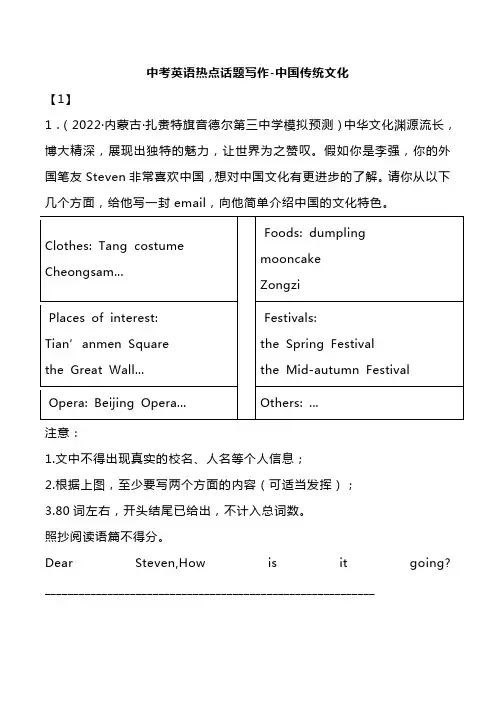
注意:1.文中不得出现真实的校名、人名等个人信息;2.根据上图,至少要写两个方面的内容(可适当发挥);3.80词左右,开头结尾已给出,不计入总词数。
照抄阅读语篇不得分。
Dear Steven,How is it going? _________________________________________________________________________________________________________________________________ _______________________________________________________________________ _______________________________________________________________________ _______________________________________________________________________ _______________________________________________________________________ _______________________________________________________________________ _______________________________________________________________________ _______________________________________________________________________ __________________________________Yours,Li Qiang【2】2.(2022·四川·富顺第三中学校三模)假如你是李华,你的外国朋友Tom 要到中国来,他想了解中国的风俗习惯,请你写一篇短文向他介绍中国的风俗习惯。
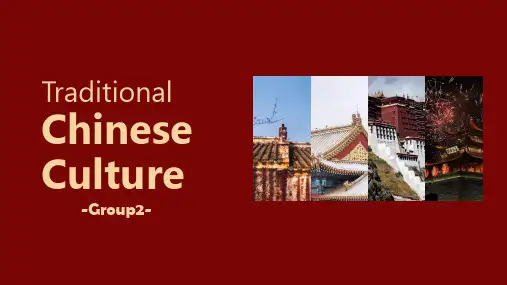
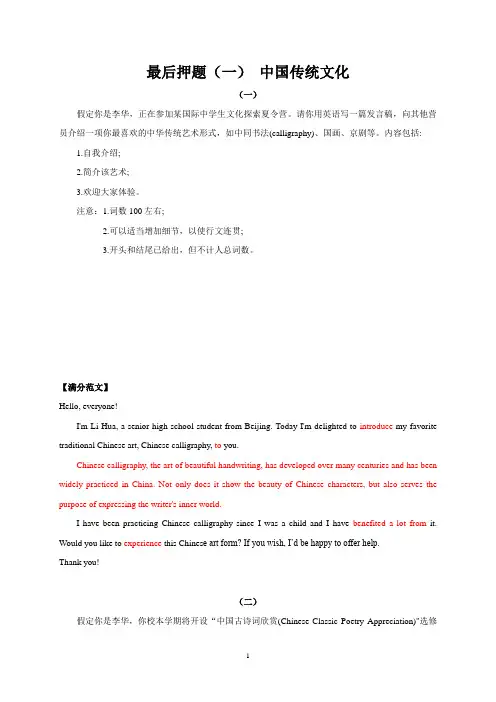
最后押题(一)中国传统文化(一)假定你是李华,正在参加某国际中学生文化探索夏令营。
请你用英语写一篇发言稿,向其他营员介绍一项你最喜欢的中华传统艺术形式,如中同书法(calligraphy)、国画、京剧等。
内容包括:1.自我介绍;2.简介该艺术;3.欢迎大家体验。
注意:1.词数100左右;2.可以适当增加细节,以使行文连贯;3.开头和结尾已给出,但不计人总词数。
______________________________________________________________________________________ ______________________________________________________________________________________ ______________________________________________________________________________________ ______________________________________________________________________________________ ______________________________________________________________________________________ ______________________________________________________________________________________ 【满分范文】Hello, everyone!I'm Li Hua, a senior high school student from Beijing. Today I'm delighted to introduce my favorite traditional Chinese art, Chinese calligraphy, to you.Chinese calligraphy, the art of beautiful handwriting, has developed over many centuries and has been widely practiced in China. Not only does it show the beauty of Chinese characters, but also serves the purpose of expressing the writer's inner world.I have been practicing Chinese calligraphy since I was a child and I have benefited a lot from it. Would you like to experience this Chines e art form? If you wish, I’d be happy to offer help.Thank you!(二)假定你是李华,你校本学期将开设“中国古诗词欣赏(Chinese Classic Poetry Appreciation)"选修课,请根据下面的写作提示,用英语给交换生Tom写一封邮件。
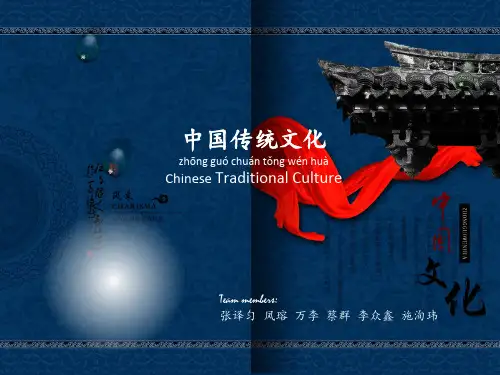
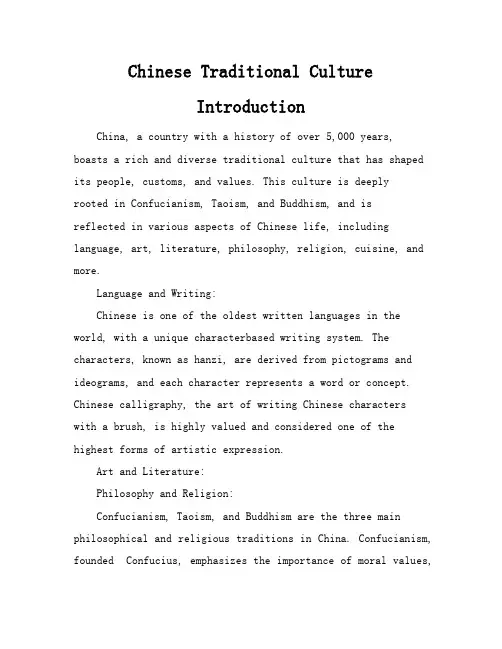
Chinese Traditional CultureIntroductionChina, a country with a history of over 5,000 years, boasts a rich and diverse traditional culture that has shaped its people, customs, and values. This culture is deeplyrooted in Confucianism, Taoism, and Buddhism, and isreflected in various aspects of Chinese life, including language, art, literature, philosophy, religion, cuisine, and more.Language and Writing:Chinese is one of the oldest written languages in the world, with a unique characterbased writing system. The characters, known as hanzi, are derived from pictograms and ideograms, and each character represents a word or concept. Chinese calligraphy, the art of writing Chinese characterswith a brush, is highly valued and considered one of the highest forms of artistic expression.Art and Literature:Philosophy and Religion:Confucianism, Taoism, and Buddhism are the three main philosophical and religious traditions in China. Confucianism, founded Confucius, emphasizes the importance of moral values,social harmony, and filial piety. Taoism, founded Laozi, emphasizes the pursuit of harmony with nature and the Tao, or the Way. Buddhism, which originated in India, focuses on the Four Noble Truths and the Eightfold Path as a means to achieve enlightenment and escape suffering.Cuisine:Chinese cuisine is one of the most diverse and flavorful in the world, with a wide variety of regional styles and dishes. Some of the most famous Chinese dishes include Peking duck, dim sum, hot pot, and dumplings. Chinese cooking techniques are also diverse, including stirfrying, steaming, boiling, and roasting.Festivals and Celebrations:China has a rich tradition of festivals and celebrations, many of which are based on the lunar calendar. Some of the most important festivals include the Spring Festival (Chinese New Year), the MidAutumn Festival, the Dragon Boat Festival, and the Lantern Festival. These festivals are celebrated with traditional customs, such as lighting lanterns, eating special foods, and watching fireworks.Traditional Medicine:Traditional Chinese medicine (TCM) is a holistic system of medicine that has been practiced for thousands of years. TCM emphasizes the balance of yin and yang, and the use ofherbal remedies, acupuncture, and other treatments to promote health and wellbeing.Conclusion:Chinese traditional culture is a treasure trove of knowledge, wisdom, and beauty. It continues to influence the lives of people in China and around the world, and is a valuable resource for understanding the history and development of human civilization.ContinuedArchitecture and Gardens:Chinese architecture is renowned for its intricate designs, use of wood, and emphasis on harmony with nature. Traditional Chinese buildings often feature curved roofs, red columns, and decorative elements such as dragons and phoenixes. Chinese gardens, known for their balance of water, rocks, plants, and architecture, are designed to create a serene and contemplative atmosphere.Music and Dance:Chinese music has a long history, with various instruments such as the guqin (a sevenstringed zither), erhu (a twostringed fiddle), and pipa (a fourstringed lute). Traditional Chinese dance is also diverse, ranging from优雅的宫廷舞到欢快的民间舞,每一种舞蹈都有其独特的风格和意义。
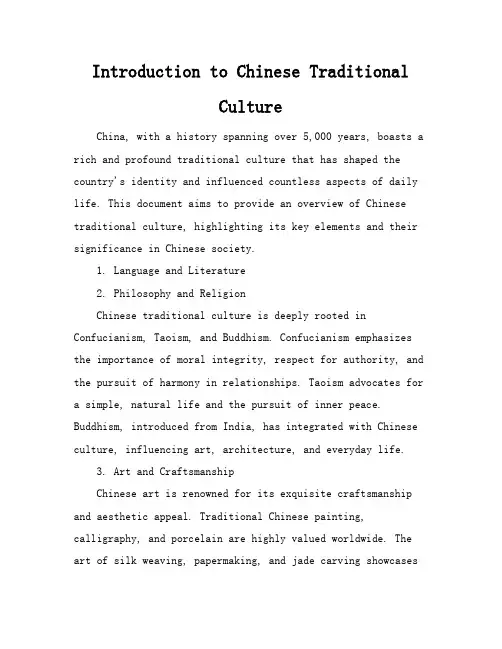
Introduction to Chinese TraditionalCultureChina, with a history spanning over 5,000 years, boasts a rich and profound traditional culture that has shaped the country's identity and influenced countless aspects of daily life. This document aims to provide an overview of Chinese traditional culture, highlighting its key elements and their significance in Chinese society.1. Language and Literature2. Philosophy and ReligionChinese traditional culture is deeply rooted in Confucianism, Taoism, and Buddhism. Confucianism emphasizes the importance of moral integrity, respect for authority, and the pursuit of harmony in relationships. Taoism advocates for a simple, natural life and the pursuit of inner peace. Buddhism, introduced from India, has integrated with Chinese culture, influencing art, architecture, and everyday life.3. Art and CraftsmanshipChinese art is renowned for its exquisite craftsmanship and aesthetic appeal. Traditional Chinese painting, calligraphy, and porcelain are highly valued worldwide. The art of silk weaving, papermaking, and jade carving showcasesthe ingenuity and skill of Chinese artisans. Moreover, the practice of Feng Shui, which aims to harmonize the flow of energy in a space, reflects the Chinese belief in the interconnectedness of nature and human life.4. Festivals and CustomsChinese festivals are a vibrant display of the country's cultural heritage. The Spring Festival (Chinese New Year) is the most important holiday, featuring traditional activities such as dragon and lion dances, fireworks, and family reunions. Other notable festivals include the Lantern Festival, Dragon Boat Festival, and MidAutumn Festival, each with its unique customs and traditions.5. Traditional ClothingThe Hanfu, a traditional Chinese attire, reflects the elegance and diversity of Chinese culture. Characterized its flowing lines and vibrant colors, Hanfu represents different social status, occasions, and historical periods. The Tang suit and Qipao are also iconic examples of Chinesetraditional clothing, showcasing the beauty and grace of Chinese women.In conclusion, Chinese traditional culture is a treasure trove of wisdom, art, and values that continue to shape the lives of people in China and around the world. By exploringthese cultural elements, we can gain a deeper understandingof the Chinese perspective on life, nature, and humanity.6. Culinary DelightsChinese cuisine is a vital part of its traditional culture, renowned for its diversity and emphasis on harmonyin flavors and ingredients. The practice of using a pair of chopsticks is not only a dining custom but also a reflectionof Chinese philosophy. Signature dishes such as Peking duck, hot pot, dim sum, and Sichuan spicy tofu (Mapo tofu)represent the rich tapestry of regional cuisines within China. The art of tea making and tea ceremonies further illustratethe Chinese pursuit of balance and tranquility in daily life.7. Architecture and GardensChinese architecture is characterized its use of wood, intricate carvings, and upturned eaves. The Forbidden City in Beijing and the classical gardens of Suzhou are prime examples of Chinese architectural excellence. Thesestructures are not only beautiful but also embody theprinciples of Feng Shui and the concept of harmony between humanity and nature. The gardens, in particular, are designed to mimic natural landscapes, providing a serene environmentfor contemplation and relaxation.8. Music and DanceChinese traditional music, with its unique scales and instruments such as the guzheng (zither), erhu (fiddle), and pipa (lute), creates a distinctive sound that is both soothing and evocative. Chinese classical dance, often performed in colorful costumes with flowing movements, tells stories and expresses emotions, drawing from historical legends and folk tales. The Peking Opera, with its elaborate costumes, makeup, and singing styles, is a famous form of traditional Chinese performing art.9. Martial Arts10. Social EtiquetteChinese society places a strong emphasis on respect, modesty, and humility. The concept of "face" (mianzi) is crucial in social interactions, representing one's reputation and social standing. Traditional greetings, such as bowing or clasping hands, and the exchange of business cards with both hands, demonstrate the importance of etiquette in Chinese culture. The practice of giftgiving, with its specific customs and taboos, is also a reflection of the respect and consideration shown in relationships.In exploring the depths of Chinese traditional culture, one cannot help but be inspired its richness and the enduring legacy it has left on the world. It is a culturethat invites us to look inward, to appreciate the beauty in simplicity, and to find harmony in the world around us.11. Folklore and MythologyChinese folklore and mythology are a tapestry of stories and legends that have been passed down through generations. These tales often feature mythical creatures like the dragon, phoenix, and qilin, which symbolize power, prosperity, and good fortune. Stories such as "Journey to the West," "Water Margin," and "The Investiture of the Gods" are not only literary masterpieces but also reflect the moral values and cultural norms of ancient China. These myths and legends continue to influence modern Chinese literature, film, and popular culture.12. Traditional Medicine13. Family ValuesFamily is the cornerstone of Chinese society, and traditional values place a strong emphasis on filial piety and ancestor worship. Elders are respected for their wisdom and experience, and the concept of "family" extends beyond the nuclear unit to include extended relatives. The family name (surname) is a source of pride and identity, often passed down through generations with a sense of duty to honor one's ancestors. The importance of family is reflected in thecelebration of festivals, where family reunions are a central tradition.14. Education and the Art of LearningEducation has always been highly valued in Chinese culture, with a focus on the pursuit of knowledge and the cultivation of moral character. The ancient Chinese education system emphasized the Four Arts: qin (a string instrument), shu (calligraphy), hua (painting), and qi (the game of Go). Today, the Chinese education system continues to be rigorous, with a strong emphasis on academic achievement and the Confucian values of respect for teachers and the importance of learning.15. Ceremonies and RitualsChinese culture is rich with ceremonies and rituals that mark life's milestones, such as births, weddings, and funerals. These events are often steeped in tradition, with specific customs and rituals that have been followed for centuries. For instance, Chinese weddings are filled with symbolic gestures, such as the exchange of red envelopes (hongbao), the tea ceremony, and the wearing of traditional attire. These rituals are not only celebratory but also serve to reinforce cultural identity and continuity.In conclusion, the depth and breadth of Chinesetraditional culture are truly aweinspiring. It is a livingheritage that continues to evolve while maintaining its roots in ancient wisdom. By understanding and appreciating these cultural elements, we gain insight into the soul of a civilization that has shaped and continues to shape the world in countless ways.。
英语四级翻译:中国传统文化英语四级翻译:中国传统文化2016年6月大学英语四级考试在即,根据的往年的情况可知,中国传统文化是翻译必考的内容之一。
为了帮助同学们备考,店铺整理了这一话题的词汇,供大家积累。
翻译大家许渊冲先生说过:“21世纪要建设世界文化,不能仅关注一个国家的文化;但要建设世界文化,中国文化在其中发挥着举足轻重的作用。
回顾中西方文化发展历史,在2000年前,中国文化和西方文化是并立的,西方有荷马史诗,中国有《诗经》、《楚辞》;在1000年前,中国有汉唐文化,西方有宗教文化,西方文化不如中国文化繁华发展;但在最近500年来,西方文化呈现压倒中国文化之势;一直到21世纪中国提出“中国梦”,中国文化逐渐复兴,才又跟西方文化并起。
”这段话告诉我们,要实现“中国梦”就要大力复兴中国文化,作为祖国的未来,我们大学生有责任有义务了解中国文化、传承中国文化。
而现在四六级考试设置也越来越把中国文化放在重要位置,下面就带领大家学习积累一些与中国文化相关的知识。
【翻译练习】Directions:For this part, you are allowed 30 minutes to translate a passage from Chinese into English. You should write your answer on Answer Sheet 2.“虚”指世界或者心灵的一种状态。
大体有两种不同的含义:其一,指世界的本原,万物皆由虚无中来。
但古人对“虚”的'这一含义又有不同理解:或认为“虚”就是空虚乌有;或认为“虚”指“气”的存在状态,因为“气”的存在隐微无形,故以“虚”称之,但并非完全空无。
其二,指虚静的或没有成见的内心状态。
【参考译文】Xu refers to a state of the cosmos or a state of mind. Basically,it has two different meanings. The first refers to the origin of the universe, indicating that everything originates from xu, Different ancient thinkers have different interpretations of this notion: Some take xu as being devoid of anything; others believe it is the state of existence of qi (气). Because qi is invisible and formless, It is said to be empty, but not a vacuum totally devoid of anything. The second meaning of xu refers to a state of mind that is peaceful, not preoccupied or simply free of any preconceptions.【传统文化词汇积累】无为而治letting nature take its own course/govern by noninterference乡土文化 native culture炎黄子孙 a Chinese descendant/the Chinese nation以德行仁 practice humanity with virtue源远流长 have a long history中国意识 Chineseness中国元素 Chinese elements中庸之道 doctrine of the mean二十四节气 24 solar terms民间工艺品 folk arts and crafts文化多样性 cultural diversification文化软实力 cultural soft power传统文化知识 traditional cultural know-how对外文化贸易 international cultural trade思想道德建设 raise ideological and ethical standards《四库全书》 Complete Works of Chinese Classics文化产业基地 cultural industrial base文化传播渠道 channels of cultural transmission文化创意产业 cultural creative industry文化体制改革reform of cultural administrative system;cultural restructuring骨干文化企业 leading/key cultural enterprises文化资源整合 integration of cultural resources新兴文化业态 emerging cultural formats改造落后的文化 transform the backward culture世界文化遗产地 world cultural heritage site弘扬民族优秀文化advance and enrich the fine cultural heritage of the nation文化下乡长效机制long-term mechanism for developing culture in rural areas重大文化产业项目 major cultural industrial projects国家一类文物保护单位 cultural relics (units) under first-grade state protection吸收外国文化有益成果absorb the achievements of foreign cultures修身、齐家、治国、平天下self-cultivation, a well-managed family, and the ability to administer the state and to bring peace to the nation天干地支 Heavenly Stems and Earthy Branches天人合一 unity of man and nature天下为公 the world or country for all文化宝藏 cultural treasures文化产业 cultural industry农耕文化 farming culture善养浩气 skillful in nourishing virtual force慎言敏行 diligent in duties and careful in speech更多英语四级翻译相关内容推荐:1.2.3.4.5.6.7.8.9.10.。
素材积累:中国文化Chinese Culture 重点短语1. traditional Chinese culture中华传统文化2. ancient Chinese characters古汉字3. learn about学习,了解4. be famous/known for因……而出名5. traditional Chinese medicine中医6. be full of/be filled with充满7. cultural heritage文化遗产8. be good for health对身体有好处9. have high artistic value有很高的艺术价值10. traditional festivals传统节日11. play an important part/role in 在…..中扮演重要角色12. carry rich information蕴含丰富的信息13. the twenty-four solar terms 24节气14. have a history of 有……的历史15. Chinese painting中国画16. paper cutting剪纸17. cherish the cultural relics珍视文化遗址18. be interested in 对……感兴趣19. make a plan制定计划20. the form of ……的形式重点句型:1. Chinese painting is one of the oldest artistic traditions in the world.中国画事是世界上最古老的艺术传统之一。
2. Tang poems are said to be the finest of Chinese literature.唐诗被称作中国文学最杰出的部分。
3. Chinese traditional sports and activities are the cultural heritage of China.中国传统运动和活动是中国的文化遗产。